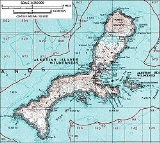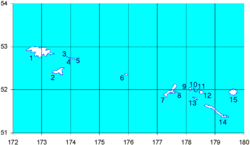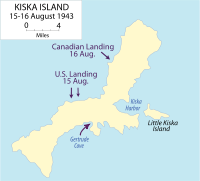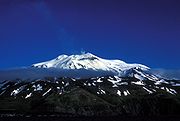
Kiska
Encyclopedia

Rat Islands
The Rat Islands are a volcanic group of islands in the Aleutian Islands in southwest Alaska, between Buldir Island and the Near Islands group to its west, and Amchitka Pass and the Andreanof Islands group to its east, at about ....
group of the Aleutian Islands of Alaska
Alaska
Alaska is the largest state in the United States by area. It is situated in the northwest extremity of the North American continent, with Canada to the east, the Arctic Ocean to the north, and the Pacific Ocean to the west and south, with Russia further west across the Bering Strait...
located at 51°57′51"N 177°27′36"E. It is about 22 miles (35.4 km) long and varies in width from 1.5 to 6 mi (2.4 to 9.7 km)
Discovery (1741)
In 1741 while returning from his second voyage at sea during the Great Northern ExpeditionGreat Northern Expedition
The Great Northern Expedition or Second Kamchatka expedition was one of the largest organised exploration enterprises in history, resulting in mapping of the most of the Arctic coast of Siberia and some parts of the North America coastline, greatly reducing the "white areas" on the maps...
, Danish-born Russian explorer Vitus Bering
Vitus Bering
Vitus Jonassen Bering Vitus Jonassen Bering Vitus Jonassen Bering (also, less correNavy]], a captain-komandor known among the Russian sailors as Ivan Ivanovich. He is noted for being the first European to discover Alaska and its Aleutian Islands...
discovered most of the Aleutian Islands, including Kiska. Georg Wilhelm Steller
Georg Wilhelm Steller
Georg Wilhelm Steller was a German botanist, zoologist, physician and explorer, who worked in Russia and is considered the discoverer of Alaska and a pioneer of Alaskan natural history.-Biography:...
, a naturalist
Naturalist
Naturalist may refer to:* Practitioner of natural history* Conservationist* Advocate of naturalism * Naturalist , autobiography-See also:* The American Naturalist, periodical* Naturalism...
-physician
Physician
A physician is a health care provider who practices the profession of medicine, which is concerned with promoting, maintaining or restoring human health through the study, diagnosis, and treatment of disease, injury and other physical and mental impairments...
aboard Bering's ship, wrote:
On 25 October 1741 we had very clear weather and sunshine, but even so it hailed at various times in the afternoon. We were surprised in the morning to discover a large tall island at 51° to the north of us.
Early history (1741–1939)
Starting in 1775, Kiska, the Aleutian Islands, and mainland Alaska became fur trading outposts for the Russian-American CompanyRussian-American Company
The Russian-American Company was a state-sponsored chartered company formed largely on the basis of the so-called Shelekhov-Golikov Company of Grigory Shelekhov and Ivan Larionovich Golikov The Russian-American Company (officially: Under His Imperial Majesty's Highest Protection (patronage)...
managed by Grigory Shelikhov
Grigory Shelikhov
Grigory Ivanovich Shelekhov Grigory Ivanovich Shelekhov Grigory Ivanovich Shelekhov (Григорий Иванович Шелехов in Russian; (1747–July 20, 1795 (July 31, 1795 N.S.)) was a Russian seafarer and merchant born in Rylsk....
.
In 1867, U.S. Secretary of State William H. Seward
William H. Seward
William Henry Seward, Sr. was the 12th Governor of New York, United States Senator and the United States Secretary of State under Abraham Lincoln and Andrew Johnson...
negotiated the purchase of Alaska with the Russian Empire
Russian Empire
The Russian Empire was a state that existed from 1721 until the Russian Revolution of 1917. It was the successor to the Tsardom of Russia and the predecessor of the Soviet Union...
. Kiska was included in the purchase.
World War II (1939–1945)

Battle of Midway
The Battle of Midway is widely regarded as the most important naval battle of the Pacific Campaign of World War II. Between 4 and 7 June 1942, approximately one month after the Battle of the Coral Sea and six months after Japan's attack on Pearl Harbor, the United States Navy decisively defeated...
. The Japanese captured the sole inhabitants of the island: a small U.S. Navy Weather Detachment consisting of ten men, including a lieutenant, along with their dog. (One member of the detachment escaped for 50 days. Starving, thin, and extremely cold, he eventually surrendered to the Japanese.) The next day the Japanese captured Attu Island
Attu Island
Attu is the westernmost and largest island in the Near Islands group of the Aleutian Islands of Alaska, making it the westernmost point of land relative to Alaska and the United States. It was the site of the only World War II land battle fought on the incorporated territory of the United States ,...
.
The military importance of this frozen, difficult-to-supply island was questionable, but the psychological impact upon the Americans of losing U.S. territory was tangible. During the winter of 1942–43, the Japanese reinforced and fortified the islands—not necessarily to prepare for an island-hopping operation across the Aleutians, but to prevent a U.S. operation across the Kuril Islands
Kuril Islands
The Kuril Islands , in Russia's Sakhalin Oblast region, form a volcanic archipelago that stretches approximately northeast from Hokkaidō, Japan, to Kamchatka, Russia, separating the Sea of Okhotsk from the North Pacific Ocean. There are 56 islands and many more minor rocks. It consists of Greater...
. The U.S. Navy began operations to deny Kiska supply which would lead to the Battle of the Komandorski Islands
Battle of the Komandorski Islands
The Battle of the Komandorski Islands was one of the most unusual engagements of World War II. It was a naval battle which took place on 27 March 1943 in the North Pacific area of the Pacific Ocean, near the Soviet Komandorski Islands.-Background:...
. During October 1942, American forces undertook seven bombing missions over Kiska, though two were aborted due to inclement weather. Following the winter, Attu was liberated and Kiska was bombed once more for over two months, before a larger American force was allocated to defeat the expected Japanese garrison of 5,200 men.
On August 15, 1943, an invasion force consisting of 34,426 Allied troops, including elements of the 7th Infantry Division, 4th Infantry Regiment, 87th Mountain Combat team, 5,300 Canadians (the 6th
6th Canadian Infantry Division
The 6th Canadian Infantry Division was a Canadian infantry division formed in 1942 during the Second World War. It was attached to Pacific Command. The division had a brigade sent to the Aleutian Islands Campaign, particularly at Kiska, but never saw action...
and 7th Infantry Divisions
7th Canadian Infantry Division
The 7th Infantry Division of the Canadian Army was mobilized in the spring of 1942 and assigned for home defence within Atlantic Command.At the time is was assumed it would consist of volunteers and proceed overseas...
), 95 ships (including three battleships and a heavy cruiser), and 168 aircraft landed on Kiska, only to find the island completely abandoned. The Japanese, aware of the loss of Attu and the impending arrival of the larger Allied force, had successfully removed their troops on July 28 under the cover of severe fog, without the Allies noticing. Allied casualties during this invasion nevertheless numbered close to 200, all either from friendly fire
Friendly fire
Friendly fire is inadvertent firing towards one's own or otherwise friendly forces while attempting to engage enemy forces, particularly where this results in injury or death. A death resulting from a negligent discharge is not considered friendly fire...
, booby traps set out by the Japanese to inflict damage on the invading allied forces, or weather-related disease. There were seventeen Americans and four Canadians killed from either friendly fire or booby traps, fifty more were wounded as a result of friendly fire or booby traps, and an additional 130 men came down with trench foot
Trench foot
Trench foot is a medical condition caused by prolonged exposure of the feet to damp, unsanitary, and cold conditions. It is one of many immersion foot syndromes...
. The destroyer USS Abner Read
USS Abner Read (DD-526)
USS Abner Read was a Fletcher-class destroyer in the service of the United States Navy, named after Lieutenant Commander Abner Read....
hit a mine, resulting in 87 casualties.
That night, however, the Imperial Japanese Navy
Imperial Japanese Navy
The Imperial Japanese Navy was the navy of the Empire of Japan from 1869 until 1947, when it was dissolved following Japan's constitutional renunciation of the use of force as a means of settling international disputes...
warships, thinking they were engaged by Americans, shelled and attempted to torpedo the island of Little Kiska and the Japanese soldiers waiting to embark. Admiral Ernest King
Ernest King
Fleet Admiral Ernest Joseph King was Commander in Chief, United States Fleet and Chief of Naval Operations during World War II. As COMINCH, he directed the United States Navy's operations, planning, and administration and was a member of the Joint Chiefs of Staff. He was the U.S...
reported to the secretary of the Navy, Frank Knox
Frank Knox
-External links:...
, that the only things that remained on the island were dogs and fresh brewed coffee
Coffee
Coffee is a brewed beverage with a dark,init brooo acidic flavor prepared from the roasted seeds of the coffee plant, colloquially called coffee beans. The beans are found in coffee cherries, which grow on trees cultivated in over 70 countries, primarily in equatorial Latin America, Southeast Asia,...
. Knox asked for an explanation and King responded, "The Japanese are very clever. Their dogs can brew coffee."
Present-day (1945–present)
The Japanese occupation siteJapanese Occupation Site, Kiska Island
The Japanese Occupation Site on Kiska island in the Rat Islands group of the Aleutian Islands of Alaska is where the Japanese Navy attacked and occupied United States territory during World War II. The Japanese invaded in June 1942 after the Battle of Dutch Harbor, capturing 10 Navy weathermen...
on the island is now considered a National Historic Landmark
National Historic Landmark
A National Historic Landmark is a building, site, structure, object, or district, that is officially recognized by the United States government for its historical significance...
(the highest level of recognition accorded to historic sites in the US) and is protected under federal law. The island is also a part of the Alaska Maritime National Wildlife Refuge
Alaska Maritime National Wildlife Refuge
The Alaska Maritime National Wildlife Refuge is a United States National Wildlife Refuge comprising 2,400 islands, headlands, rocks, islets, spires and reefs in Alaska, with a total area of , of which is wilderness)...
(AMNWR) and contains the largest colony
Bird colony
A bird colony is a large congregation of individuals of one or more species of bird that nest or roost in close proximity at a particular location. Many kinds of birds are known to congregate in groups of varying size; a congregation of nesting birds is called a breeding colony...
of Least Auklet
Least Auklet
The Least Auklet, Aethia pusilla, is a seabird and the smallest species of auk. It is the most abundant seabird in North America, and one of the most abundant in the world, with a population of around nine million birds. They breed on the islands of Alaska and Siberia, and spend the winter close to...
s (over 1,160,000 birds) and Crested Auklet
Crested Auklet
The Crested Auklet is a small seabird of the family Alcidae which nests in huge colonies in the Bering Sea and Sea of Okhotsk. They often breed in mixed-species colonies with Least Auklets, their smaller congener.The Crested Auklet can measure in length, in wingspan and weigh...
s. Research biologist
Biologist
A biologist is a scientist devoted to and producing results in biology through the study of life. Typically biologists study organisms and their relationship to their environment. Biologists involved in basic research attempt to discover underlying mechanisms that govern how organisms work...
s from Memorial University of Newfoundland
Memorial University of Newfoundland
Memorial University of Newfoundland, is a comprehensive university located primarily in St...
have been studying the impact of introduced Norway Rats
Brown Rat
The brown rat, common rat, sewer rat, Hanover rat, Norway rat, Brown Norway rat, Norwegian rat, or wharf rat is one of the best known and most common rats....
on the seabird
Seabird
Seabirds are birds that have adapted to life within the marine environment. While seabirds vary greatly in lifestyle, behaviour and physiology, they often exhibit striking convergent evolution, as the same environmental problems and feeding niches have resulted in similar adaptations...
s of Kiska since 2001.
Much of the aftermath left behind from World War II is still evident in Kiska. The slow erosion
Erosion
Erosion is when materials are removed from the surface and changed into something else. It only works by hydraulic actions and transport of solids in the natural environment, and leads to the deposition of these materials elsewhere...
processes on the tundra
Tundra
In physical geography, tundra is a biome where the tree growth is hindered by low temperatures and short growing seasons. The term tundra comes through Russian тундра from the Kildin Sami word tūndâr "uplands," "treeless mountain tract." There are three types of tundra: Arctic tundra, alpine...
have had little effect on the bomb craters still visible both from the ground and in satellite images on the hills surrounding the harbor. Numerous equipment dumps, tunnels (some concrete-lined), Japanese gun emplacements, shipwreck
Shipwreck
A shipwreck is what remains of a ship that has wrecked, either sunk or beached. Whatever the cause, a sunken ship or a wrecked ship is a physical example of the event: this explains why the two concepts are often overlapping in English....
s, and other war relics can be found all untouched since 1943.
In 1983, a memorial plaque was placed on Kiska by the 87th Mountain Infantry Regiment. The plaque's inscription reads:
To the men of Amphibious Task Force 9 who fell here August 1943 placed here August 1983 by 87th Mountain Infantry Regiment.
On August 22, 2007, the remains of a World War II submarine were found more than six decades after the U.S. Navy vessel disappeared with a crew of 70 off the Aleutian Island of Kiska. The submarine is the USS Grunion.
In Fiction
Renamed "Skira", the island was used as the setting for the CodemastersCodemasters
The Codemasters Software Company Limited, or Codemasters is a British video game developer founded by Richard and David Darling in 1986...
video game Operation Flashpoint: Dragon Rising. The fictionalized version of the island is relocated closer to Russia and China, but the island's topography is replicated near-exactly, with elements of the game designed around it, instead of vice-versa.
Kiska Volcano

Stratovolcano
A stratovolcano, also known as a composite volcano, is a tall, conical volcano built up by many layers of hardened lava, tephra, pumice, and volcanic ash. Unlike shield volcanoes, stratovolcanoes are characterized by a steep profile and periodic, explosive eruptions...
, 5.3 by in diameter
Diameter
In geometry, a diameter of a circle is any straight line segment that passes through the center of the circle and whose endpoints are on the circle. The diameters are the longest chords of the circle...
at its base and 4006 feet (1,221 m) high, located on the northern end of Kiska Island.
On January 24, 1962, an explosive eruption occurred, accompanied by lava
Lava
Lava refers both to molten rock expelled by a volcano during an eruption and the resulting rock after solidification and cooling. This molten rock is formed in the interior of some planets, including Earth, and some of their satellites. When first erupted from a volcanic vent, lava is a liquid at...
extrusion and the construction of a cinder cone
Cinder cone
According to the , Cinder Cone is the proper name of 1 cinder cone in Canada and 7 cinder cones in the United States:In Canada: Cinder Cone In the United States:...
about 98 feet (30 m) high at Sirius Point on the north flank of Kiska Volcano, 1.9 miles (3.1 km) from the summit of the main cone (Anchorage Daily News
Anchorage Daily News
The Anchorage Daily News is a daily newspaper based in Anchorage, Alaska, in the United States. It is often referred to colloquially as either "the Daily News" or "the ADN"...
, January 30, 1962). A second eruption that produced a lava flow was reported to have occurred on March 18, 1964 (Bulletin of Volcanic Eruptions, 1964).
Since then the volcano has emitted steam and ash
Volcanic ash
Volcanic ash consists of small tephra, which are bits of pulverized rock and glass created by volcanic eruptions, less than in diameter. There are three mechanisms of volcanic ash formation: gas release under decompression causing magmatic eruptions; thermal contraction from chilling on contact...
plumes as well as smaller lava flows.
See also
- Report from the AleutiansReport from the AleutiansReport From the Aleutians is a 47-minute documentary propaganda film produced by the U.S. Army Signal Corps about the Aleutian Islands Campaign during World War II...
, a 1943 documentary about the bombing of Kiska during World War II
External links
- Kiska Volcano
- Shipwrecks around Kiska
- The Kiska Memorial
- The Aleutians Campaign
- Library of Congress link
- Alaska Volcano Observatory
- Soldiers of the 184th Infantry, 7th ID in the Pacific, 1943-1945
- Long-term study of the impact of introduced rats on the seabirds (Memorial University of Newfoundland)
- A picture gallery from the journey to locate the U.S. WWII submarine "Grunion" sunk near Kiska
- Photos from Kiska Island, July 2008

